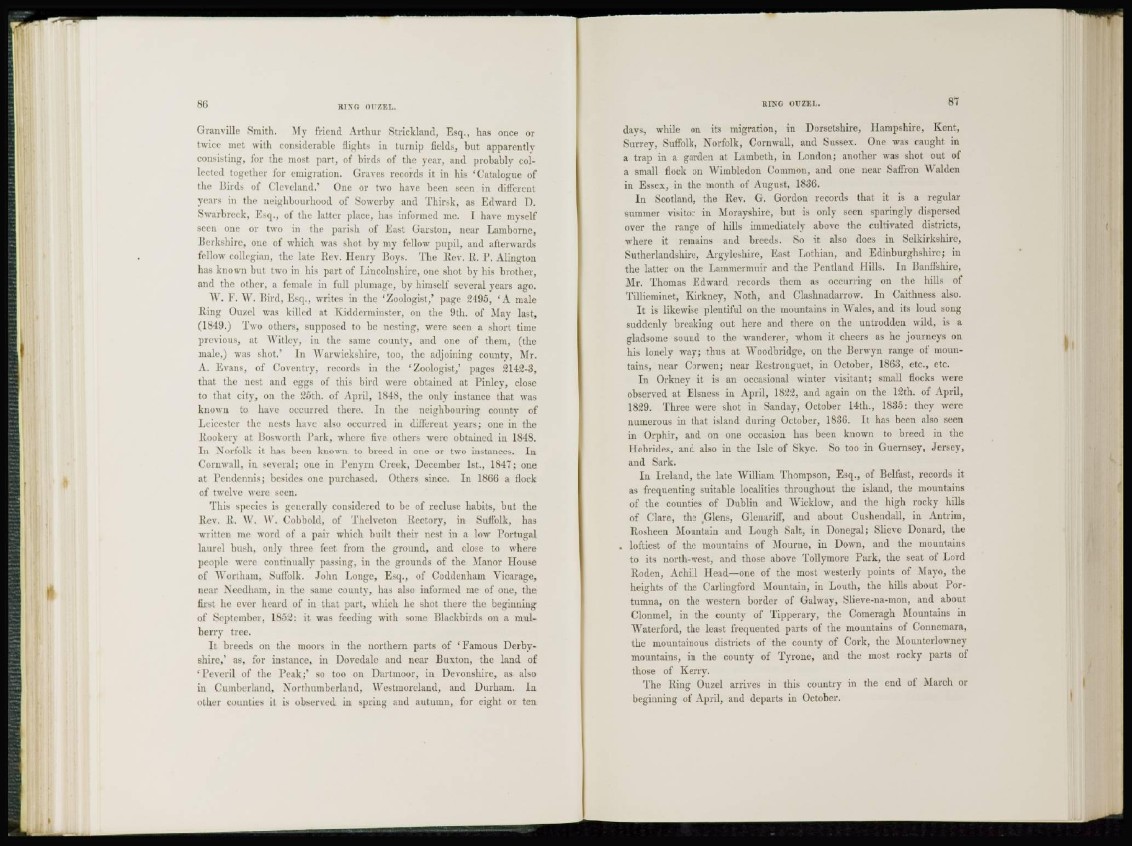
86 RING OUZEL.
Granville Smith. My friend Arthur Strickland, Esq., has once or
twice met with considerable nights in turnip fields, but apparently
consisting, for the most part, of birds of the year, and probably collected
together for emigration. Graves records it in his 'Catalogue of
the Birds of Cleveland.' One or two have been seen in different
years in the neighbourhood of Sowerby and Thirsk, as Edward D.
Swarbreck, Esq., of the latter place, has informed me. I have myself
seen one or two in the parish of East Garston, near Lamborne,
Berkshire, one of which was shot by my fellow pupil, and afterwards
fellow collegian, the late Rev. Henry Boys. The Rev. R. P. Alington
has known but two in his part of Lincolnshire, one shot by his brother,
and the other, a female in full plumage, by himself several years ago.
W. F. W. Bird, Esq., writes in the 'Zoologist,' page 2495, ' A male
Ring Ouzel was killed at Kidderminster, on the 9th. of May last,
(1849.) Two others, supposed to be nesting, were seen a short time
previous, at Wit ley, in the same county, and one of them, (the
male,) was shot.' In Warwickshire, too, the adjoining county, Mr.
A. Evans, of Coventry, records in the 'Zoologist,' pages 2142-3,
that the nest and eggs of this bird were obtained at Pinley, close
to that city, on the 25th. of April, 1848, the only instance that was
known to have occurred there. In the neighbouring county of
Leicester the nests have also occurred in different years; one in the
Rookery at Bosworth Park, where five others were obtained in 1848.
I n Norfolk it has been known to breed in one or two instances. In
Cornwall, in several; one in Penyrn Creek, December 1st., 1847; one
at Pcndennis; besides one purchased. Others since. In I860 a flock
of twelve were seen.
This species is generally considered to be of recluse habits, but the
Rev. R. W. W. Cobbold, of Thclveton Rectory, in Suffolk, has
written me word of a pair which built their nest in a low Portugal
laurel bush, only three feet from the ground, and close to where
people were continually passing, in the grounds of the Manor House
of Wortham, Suffolk. John Longe, Esq., of Coddenham Vicarage,
near Needham, in the same county, has also informed me of one, the
first he ever heard of in that part, which he shot there the beginning
of September, 18-3:*: it was feeding with some Blackbirds on a mulberry
tree.
I t breeds on the moors in the northern parts of 'Famous Derbyshire,'
as, for instance, in Dovedalc and near Buxton, the land of
' Peveril of the Peak;' so too on Dartmoor, in Devonshire, as also
in Cumberland, Northumberland, Westmoreland, and Durham. In
other counties it is observed in spring and autumn, for eight or ten
RING OUZEL. ST
days, while on its migration, in Dorsetshire, Hampshire, Kent,
Surrey, Suffolk, Norfolk, Cornwall, and Sussex. One was caught in
a trap in a garden at Lambeth, in London; another was shot out of
a small flock on Wimbledon Common, and one near Saffron Walden
in Essex, in the month of August, 1836.
I n Scotland, the Rev. G. Gordon records that it is a regular
summer visitor in Morayshire, but is only seen sparingly dispersed
over the range of hills immediately above the cultivated districts,
where it remains and breeds. So it also does in Selkirkshire,
Suthcrlaudshire, Argvleshire, East Lothian, and Edinburghshire; in
the latter on the Lammermuir and the Pentland Hills. In Banffshire,
Mr. Thomas Krlward records them as occurring on the hills of
Tillieminet, Kirkney, Noth, and Clashnadarrow. In Caithness also.
I t is likewise plentiful on the mountains in Wales, and its loud song
suddenly breaking out here and there on the untrodden wild, is a
gladsome sound to the wanderer, whom it cheers as he journeys on
his lonely way; thus at Woodbridge, on the Berwyn range of mountains,
near Corwen; near Rcstronguet, in October, 1863, etc., etc.
I n Orkney it is an occasional winter visitant; small flocks were
observed at Elsness in April, 1822, and again on the 12th. of April,
1829. Three were shot in Sanday, October 14th., 1835: they were
numerous in that island during October, 1836. It has been also seen
in Orphir, and on one occasion has been known to breed in the
Hebrides, and also in the Isle of Skye. So too in Guernsey, Jersey,
and Sark.
I n Ireland, the late William Thompson, Esq., of Belfast, records it
as frequenting suitable localities throughout the island, the mountains
of the counties of Dublin and Wicklow, and the high rocky hills
of Clare, the ^ Glens, Glenariff, and about Cushendall, in Antrim,
Rosheen Mountain and Lough Salt, in Donegal; Slieve Donard, the
loftiest of the mountains of Mourne, in Down, and the mountains
to its north-west, and those above Tollymore Park, the seat of Lord
Roden, Achill Head—one of the most westerly points of Mayo, the
heights of the Carlingford Mountain, in Louth, the hills about Portumna,
on the western border of Galway, Slieve-na-mon, and about
Clonmel, in the county of Tipperary, the Comeragh Mountains in
Waterford, the least frequented parts of the mountaius of Connemara,
the mountainous districts of the county of Cork, the Mounterlowney
mountains, in the county of Tyrone, and the most rocky parts of
those of Kerry.
The Ring Ouzel arrives in this country in the end of March or
beginning of April, and departs in October.